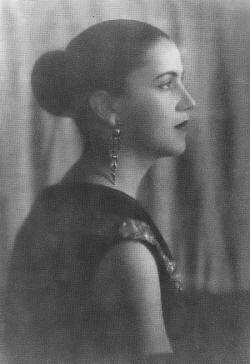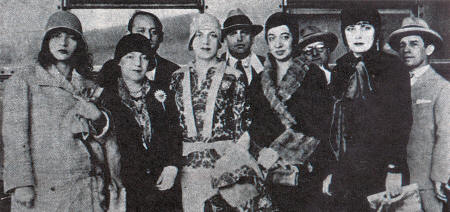

Partner Pagu
Queer Places:
Av. Tarsila do Amaral, Capivari - SP, 13360-000, Brazil
Académie Julian, Passage des Panoramas, 75002 Paris
 Tarsila de Aguiar do Amaral (September 1, 1886[1]
– January 17, 1973), internationally known as Tarsila do Amaral or
simply Tarsila, is considered one of the leading Latin American
modernist artists, described as "the Brazilian painter who best achieved
Brazilian aspirations for nationalistic expression in a modern style."[2]
She had a relationship with Pagu, a Brazilian writer,
poet, playwright, journalist, and translator. Pagu was with Tarsila in 1929 when
she met her
next partner, Elsie Houston, a Brazilian poet living in France and was married
to French surrealist artist Benjamin Péret.
Tarsila de Aguiar do Amaral (September 1, 1886[1]
– January 17, 1973), internationally known as Tarsila do Amaral or
simply Tarsila, is considered one of the leading Latin American
modernist artists, described as "the Brazilian painter who best achieved
Brazilian aspirations for nationalistic expression in a modern style."[2]
She had a relationship with Pagu, a Brazilian writer,
poet, playwright, journalist, and translator. Pagu was with Tarsila in 1929 when
she met her
next partner, Elsie Houston, a Brazilian poet living in France and was married
to French surrealist artist Benjamin Péret.
Tarsila do Amaral was a member of the Grupo dos Cinco, which was a group of five Brazilian artists who are considered the biggest influence in the modern art movement in Brazil. The other members of the Grupo dos Cinco are Anita Malfatti, Menotti Del Picchia, Mário de Andrade, and Oswald de Andrade. Tarsila was also instrumental in the formation of the Antropofagia movement (1928-1929); she was in fact the one who inspired Oswald de Andrade's famous Anthropophagic Manifesto.[3]
Tarsila do Amaral was born in Capivari,[4] a small town in the countryside of the state of São Paulo. She was born to a wealthy family of farmers and landowners who grew coffee, two years before the end of slavery in Brazil.[5] At that time in Brazil women were not encouraged to seek higher education, especially if they came from affluent families. Despite coming from a well-to-do family, Tarsila had her family's support in obtaining higher education. As a teenager, Tarsila and her parents traveled to Spain, where Tarsila caught people's eyes by drawing and painting copies of the artwork she saw at her school's archives.[6] Tarsila attended school in Barcelona, and later trained privately in her hometown under painter, Pedro Alexandrino Borges (1864-1942). She also attended the Academie Julian in Paris and studied with other prominent artists (1920-1923).[7]
In 1926, Tarsila married Oswald de Andrade and they continued to travel throughout Europe and Middle East. In Paris, in 1926, she had her first solo exhibition at the Galerie Percier. The paintings shown at the exhibition included São Paulo (1924), A Negra[12] (1923), Lagoa Santa (1925), and Morro de Favela (1924). Her works were praised and called "exotic", "original", "naïve", and "cerebral", and they commented on her use of bright colors and tropical images.[13]

From left to right: Pagu, Elsie Lessa, Tarsila do Amaral, Anita Malfatti & Eugênia Álvaro Moreyra circa 1928
In 1931, Tarsila traveled to the Soviet Union.[1] While there, she had exhibitions of her works in Moscow at the Museum of Occidental Art, and she traveled to various other cities and museums. The poverty and plight of the Russian people had a great effect on her, as seen in her painting Workers (Operarios) (1933).[18] Upon her return to Brazil in 1932, she became involved in the São Paulo Constitutional Revolt against the dictatorship in Brazil, led by Getúlio Vargas. Along with others who were seen as leftist, she was imprisoned for a month because her travels made her appear to be a communist sympathizer.
The remainder of her career she focused on social themes. Representative of this period is the painting Segundo Class (1931), which has impoverished Russian men, women and children as the subject matter. She also began writing a weekly arts and culture column for the Diario de São Paulo, which continued until 1952.
In 1938, Tarsila finally settled permanently in São Paulo where she spent the remainder of her career painting Brazilian people and landscapes. In 1950, she had an exhibition at Museum of Modern Art, São Paulo where a reviewer called her "the most Brazilian of painters here, who represents the sun, birds, and youthful spirits of our developing country, as simple as the elements of our land and nature…. She died in São Paulo 1973.[1] Tarsila's life is a mark of the warm Brazilian character and an expression of it tropical exuberance."[19]
Besides the 230 paintings, hundreds of drawings, illustrations, prints, murals, and five sculptures, Tarsila's legacy is her effect on the direction of Latin American art. Tarsila moved modernism forward in Latin America, and developed a style unique to Brazil. Following her example, other Latin American artists were influenced to begin utilizing indigenous Brazilian subject matter, and developing their own style. The Amaral Crater on Mercury is named after her.
In 2018 MoMA opened a solo exhibition of her work, the eighth retrospective on Latin America artists following exhibitions on Diego Rivera, Cândido Portinari, Roberto Matta, Manuel Álvarez Bravo, Armando Reverón, José Clemente Orozco and Joaquín Torres García.
My published books: